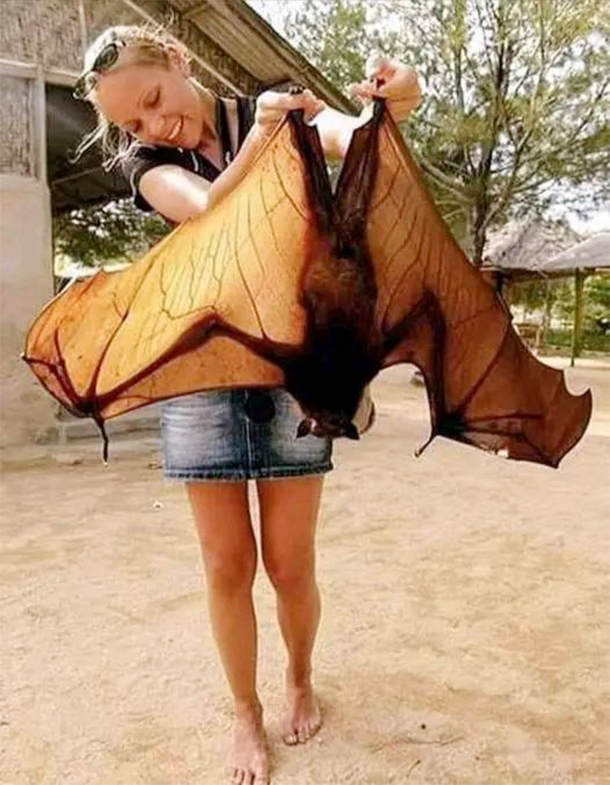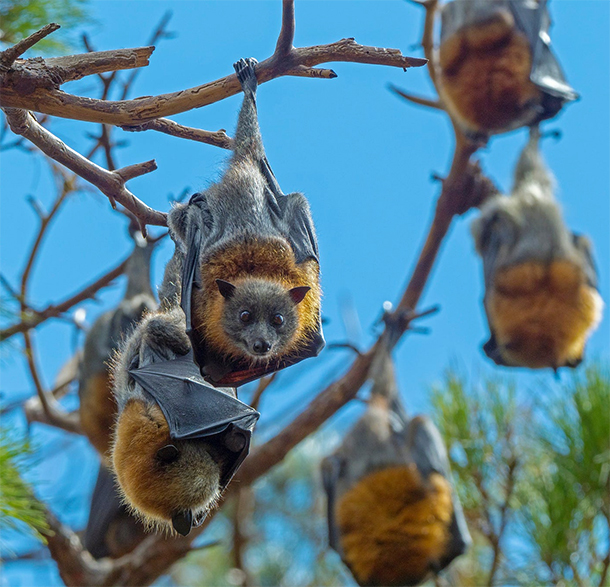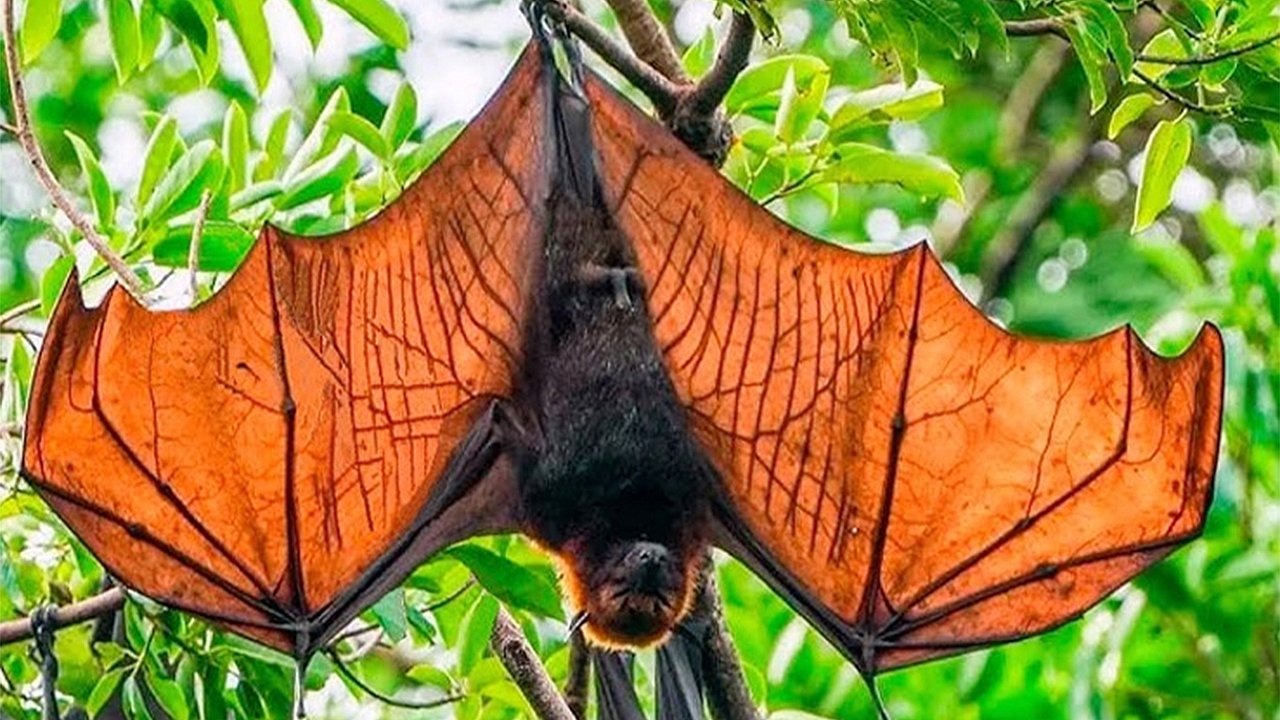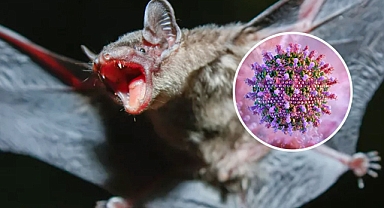Nature’s Winged Wonder: The Giant Golden-Crowned Flying Fox
The Giant Golden-Crowned Flying Fox (Acerodon jubatus) is one of nature's most extraordinary creatures. Its species name comes from the striking golden fur on its head, contrasting with its dark body. Known for its immense size, this fruit bat boasts a wingspan of 1.5 to 1.7 meters (4 feet 10 inches to 5 feet 7 inches) and weighs between 0.7 to 1.2 kilograms (1.5 to 2.6 pounds). Despite its size, it shares traits with other fruit bats, including a lack of a tail and an affinity for figs. These bats are real and not products of photo editing, though their size often leaves people in disbelief. Their incredible wings make them look draped in black capes while sleeping. With such an appearance, it's no wonder they’re often described as looking like something out of a fantasy novel.Rare and Reclusive
These bats are real and not products of photo editing, though their size often leaves people in disbelief. Their incredible wings make them look draped in black capes while sleeping. With such an appearance, it's no wonder they’re often described as looking like something out of a fantasy novel.Rare and Reclusive
The Giant Golden-Crowned Flying Fox is elusive, thriving in the dense forests of the Philippines. They can be found from sea level up to 1,100 meters (3,600 feet) in elevation. Observing them is difficult due to their nocturnal habits and preference for remote, human-free areas. Studies show they can travel up to 25 miles in a single night in search of food. Because they rely heavily on intact forest ecosystems, deforestation poses a significant threat to their survival. They are considered forest obligate species, meaning their presence is tightly linked to healthy, undisturbed forest habitats.Conservation Challenges
Because they rely heavily on intact forest ecosystems, deforestation poses a significant threat to their survival. They are considered forest obligate species, meaning their presence is tightly linked to healthy, undisturbed forest habitats.Conservation Challenges
Efforts to protect the Giant Golden-Crowned Flying Fox are underway, with organizations like Bat Conservation International and the World Wildlife Fund leading the charge. In the Philippines, the Maitum government in Sarangani has launched initiatives to safeguard this species. Subic Bay, a 14,000-acre protected area, plays a key role in conservation efforts and research.Megabats vs. Microbats
Unlike microbats, megabats, including this species, do not rely on echolocation to navigate. Instead, they use their large eyes and keen sense of smell to orient themselves, especially in twilight or forested areas. A notable exception is the Egyptian fruit bat, which uses tongue clicks for echolocation. The evolutionary loss of echolocation in megabats may be due to their larger body size, which disrupts the energy-efficient coupling of flight and echolocation seen in smaller bat species.How to Help
You can contribute to preserving this incredible species by supporting conservation groups such as the Lubee Foundation or the Wildlife Conservation Society. They fund research, provide education, and work tirelessly to protect the habitats of these fascinating creatures. With their massive size, mysterious nature, and forest-dwelling habits, the Giant Golden-Crowned Flying Fox is truly one of the planet’s most intriguing animals—a living reminder of the beauty and wonder that still exists in our natural world.
With their massive size, mysterious nature, and forest-dwelling habits, the Giant Golden-Crowned Flying Fox is truly one of the planet’s most intriguing animals—a living reminder of the beauty and wonder that still exists in our natural world.
The Giant Golden-Crowned Flying Fox (Acerodon jubatus) is one of nature's most extraordinary creatures. Its species name comes from the striking golden fur on its head, contrasting with its dark body. Known for its immense size, this fruit bat boasts a wingspan of 1.5 to 1.7 meters (4 feet 10 inches to 5 feet 7 inches) and weighs between 0.7 to 1.2 kilograms (1.5 to 2.6 pounds). Despite its size, it shares traits with other fruit bats, including a lack of a tail and an affinity for figs.
 These bats are real and not products of photo editing, though their size often leaves people in disbelief. Their incredible wings make them look draped in black capes while sleeping. With such an appearance, it's no wonder they’re often described as looking like something out of a fantasy novel.Rare and Reclusive
These bats are real and not products of photo editing, though their size often leaves people in disbelief. Their incredible wings make them look draped in black capes while sleeping. With such an appearance, it's no wonder they’re often described as looking like something out of a fantasy novel.Rare and ReclusiveThe Giant Golden-Crowned Flying Fox is elusive, thriving in the dense forests of the Philippines. They can be found from sea level up to 1,100 meters (3,600 feet) in elevation. Observing them is difficult due to their nocturnal habits and preference for remote, human-free areas. Studies show they can travel up to 25 miles in a single night in search of food.
 Because they rely heavily on intact forest ecosystems, deforestation poses a significant threat to their survival. They are considered forest obligate species, meaning their presence is tightly linked to healthy, undisturbed forest habitats.Conservation Challenges
Because they rely heavily on intact forest ecosystems, deforestation poses a significant threat to their survival. They are considered forest obligate species, meaning their presence is tightly linked to healthy, undisturbed forest habitats.Conservation ChallengesEfforts to protect the Giant Golden-Crowned Flying Fox are underway, with organizations like Bat Conservation International and the World Wildlife Fund leading the charge. In the Philippines, the Maitum government in Sarangani has launched initiatives to safeguard this species. Subic Bay, a 14,000-acre protected area, plays a key role in conservation efforts and research.Megabats vs. Microbats
Unlike microbats, megabats, including this species, do not rely on echolocation to navigate. Instead, they use their large eyes and keen sense of smell to orient themselves, especially in twilight or forested areas. A notable exception is the Egyptian fruit bat, which uses tongue clicks for echolocation. The evolutionary loss of echolocation in megabats may be due to their larger body size, which disrupts the energy-efficient coupling of flight and echolocation seen in smaller bat species.How to Help
You can contribute to preserving this incredible species by supporting conservation groups such as the Lubee Foundation or the Wildlife Conservation Society. They fund research, provide education, and work tirelessly to protect the habitats of these fascinating creatures.
 With their massive size, mysterious nature, and forest-dwelling habits, the Giant Golden-Crowned Flying Fox is truly one of the planet’s most intriguing animals—a living reminder of the beauty and wonder that still exists in our natural world.
With their massive size, mysterious nature, and forest-dwelling habits, the Giant Golden-Crowned Flying Fox is truly one of the planet’s most intriguing animals—a living reminder of the beauty and wonder that still exists in our natural world.








